Tribological Properties of Si3N4-hBN Composite Ceramics Bearing on GCr15 under Seawater Lubrication
Abstract
:1. Introduction
2. Materials Prepareds and Methods Applied
2.1. Materials Prepared and Specimens Made
2.2. Test Methods
3. Findings and Discussion
3.1. Characteristics of Friction and Wear
3.2. Characterization of the Worn Surfaces with SEM
3.3. XPS Analysis on the Worn Surfaces
3.4. Characterization of Seawater Lubrication
4. Conclusions
Author Contributions
Funding
Conflicts of Interest
References
- Wang, W.; Wen, H.X.; Chen, W. Research Status on Tribological Behaviors of Materials under Seawater Environment. Mater. Rev. 2017, 31, 51–58. [Google Scholar]
- Yang, M.; Wang, Q.; Lv, M.; Zhu, H. Synthesis and sintering of silicon nitride nano-powders via sodium reduction in liquid ammonia. J. Eur. Ceram. Soc. 2016, 36, 1899–1904. [Google Scholar] [CrossRef]
- Krstic, Z.; Krstic, V.D. Silicon nitride: The engineering material of the future. J. Mater. Sci. 2012, 47, 535–552. [Google Scholar] [CrossRef]
- Carrasquero, E.; Bellosi, A.; Staia, M.H. Characterization and wear behavior of modified silicon nitride. Int. J. Refract. Met. Hard Mater. 2005, 23, 391–397. [Google Scholar] [CrossRef]
- Chen, W.; Gao, Y.M.; Chen, L.; Li, H.; Chen, C. Study on the tribological characteristics of Si3N4-hBN ceramic materials sliding against Fe-B alloy. Lubr. Eng. 2012, 37, 29–36. [Google Scholar]
- Wu, D.; Liu, Y.; Li, N.; Zhao, X.; Ren, X. The applicability of WC-10Co-4Cr/Si3N4 tribopair to the different natural waters. Int. J. Refract. Met. Hard Mater. 2016, 54, 19–26. [Google Scholar] [CrossRef]
- Liu, N.; Wang, J.; Chen, B.; Yan, F. Tribochemical aspects of silicon nitride ceramic sliding against stainless steel under the lubrication of seawater. Tribol. Int. 2013, 61, 205–213. [Google Scholar] [CrossRef]
- Liu, C.C.; Huang, J.L. Tribological characteristics of Si3N4-based composites in unlubricated sliding against steel ball. Mater. Sci. Eng. 2004, 384, 299–307. [Google Scholar] [CrossRef]
- Akdogan, G.; Stolarski, T.A. Wear in metal/silicon nitride sliding pairs. Ceram. Int. 2003, 29, 435–446. [Google Scholar] [CrossRef]
- Chen, M.; Kato, K.; Adachi, K. The comparisons of sliding speed and normal load effect on friction coefficients of self-mated Si3N4 and SiC under water lubrication. Tribol. Int. 2002, 35, 129–135. [Google Scholar] [CrossRef]
- Ferreira, V.; Yoshimura, H.N.; Sinatora, A. Ultra-low friction coefficient in alumina–silicon nitride pair lubricated with water. Wear 2012, 296, 656–659. [Google Scholar] [CrossRef]
- Oliveira, R.P.D.; Santos, E.D.; Cousseau, T.; Sinatora, A.; Oliveira, R.P.; Santos, E.; Cousseau, T.; Sinatora, A. Effect of PH on wear and friction of silicon nitride sliding against alumina in water. Tribol. Int. 2015, 90, 356–361. [Google Scholar] [CrossRef]
- Kovalčíková, A.; Balko, J.; Balázsi, C.; Hvizdos, P.; Dusza, J. Influence of hBN content on mechanical and tribological properties of Si3N4/BN ceramic composites. J. Eur. Ceram. Soc. 2014, 34, 3319–3328. [Google Scholar] [CrossRef]
- Li, X.; Gao, Y.; Wei, S.; Yang, Q.; Zhong, Z. Dry sliding tribological properties of self-mated couples of B4C-hBN ceramic composites. Ceram. Int. 2017, 43, 162–166. [Google Scholar] [CrossRef]
- Li, X.; Gao, Y.; Yang, Q.; Pan, W.; Li, Y.; Zhong, Z.; Song, L. Evaluation of tribological behavior of B4C-hBN ceramic composites under water-lubricated condition. Ceram. Int. 2015, 41, 7387–7393. [Google Scholar] [CrossRef]
- Chen, W.; Zhang, D.; Ai, X. Effect of load on the friction and wear characteristics of Si3N4-hBN ceramic composites sliding against steels. Ceram. Int. 2016, 43, 4379–4389. [Google Scholar] [CrossRef]
- Ai, X.; Gao, D.-Q.; Chen, W.; Lv, Z.-L. Tribological behaviour of Si3N4-hBN ceramic materials against metal with different sliding speeds. Ceram. Int. 2016, 42, 10132–10432. [Google Scholar] [CrossRef]
- Chen, W.; Gao, Y.M.; Ju, F.L.; Wang, Y. Tribochemical Behavior of Si3N4–hBN Ceramic Materials with Water Lubrication. Tribol. Lett. 2010, 37, 229–238. [Google Scholar] [CrossRef]
- Zhang, D.; Chen, W.; Ai, X.; Lv, Z.-L. Effect of the humidity on the friction and wear characteristics of Si3N4-hBN composite ceramics, ARCHIVE Proceedings of the Institution of Mechanical Engineers Part. J. Eng. Tribol. 2017, 208–210, 1994–1996. [Google Scholar]
- Chen, W.; Zhang, D.; Lv, Z.; Li, H. Self-lubricating mechanisms via the in situ formed tribo-film of sintered ceramics with hBN addition in a high humidity environment. Int. J. Refract. Met. Hard Mater. 2017, 66, 163–173. [Google Scholar] [CrossRef]
- Tomizawa, H.; Fischer, T.E. Friction and Wear of Silicon Nitride and Silicon Carbide in Water: Hydrodynamic Lubrication at Low Sliding Speed Obtained by Tribochemical Wear. ASLE Trans. 1987, 30, 41–46. [Google Scholar] [CrossRef]
- Kurz, J.; Amann, T.; Kailer, A. Tribological Investigations of Silicon Nitride Lubricated by Ionic Liquid Aqueous Solutions. Tribol. Trans. 2019, 62, 295–303. [Google Scholar] [CrossRef]
- Chen, W.; Gao, Y.; Wang, Y.; Li, H. Tribological Behavior of Si3N4-hBN Ceramic Materials without Lubrication under Different Test Modes. Tribol. Trans. 2010, 53, 787–798. [Google Scholar] [CrossRef]
- Chen, W.; Wang, K.; Liu, X.; He, N.; Xin, H.; Hao, W. Investigation of the friction and wear characteristics of Si3N4-hBN ceramic composites under marine atmospheric environment. Int. J. Refract. Met. Hard Mater. 2019, 81, 345–357. [Google Scholar] [CrossRef]
- Chen, W.; Wang, K.; Gao, Y.; He, N.; Xin, H.; Li, H. Investigation of tribological properties of silicon nitride ceramic composites sliding against titanium alloy under artificial seawater lubricating condition. Int. J. Refract. Met. Hard Mater. 2018, 76, 204–213. [Google Scholar] [CrossRef]
- Jahanmir, S.; Fischer, T.E. Friction and Wear of Silicon Nitride Lubricated by Humid Air, Water, Hexadecane and Hexadecane + 0.5 Percent Stearic Acid. Tribol. Trans. 1988, 31, 32–43. [Google Scholar] [CrossRef]
- Chen, W.; Gao, Y.; Chen, L.; Li, H. Influence of Sliding Speed on the Tribological Characteristics of Si3N4-hBN Ceramic Materials. Tribol. Trans. 2014, 56, 1035–1045. [Google Scholar] [CrossRef]
- Liu, S.X. Manual for Practical Metal Materials; Machine Press: Beijing, China, 2017. [Google Scholar]
- Standard Practice for the Preparation of Substitute Ocean Water; ASTM D1141-98(2008); ASTM International: West Conshohocken, PA, USA, 2008.
- Kalin, M. Influence of flash temperatures on the tribological behaviour in low speed sliding: A review. Mater. Sci. Eng. 2004, 374, 390–397. [Google Scholar] [CrossRef]
- Wang, S.; Cheng, J.; Zhu, S.; Qiao, Z.; Yang, J.; Liu, W. Frictional properties of Ti3AlC2 ceramic against different counterparts in deionized water and artificial seawater. Ceram. Int. 2016, 42, 4578–4585. [Google Scholar] [CrossRef]
- Chen, B.B.; Wang, J.Z.; Yan, F.Y. Friction and Wear Behaviors of Several Polymers Sliding Against GCr15 and AISI316 Steel Under the Lubrication of Sea Water. Tribol. Lett. 2011, 42, 17–25. [Google Scholar] [CrossRef]
- Wang, J.Z.; Yan, F.Y.; Xue, Q.J. Tribological behavior of PTFE sliding against steel in sea water. Wear 2009, 267, 1634–1641. [Google Scholar] [CrossRef]
- Guan, X.Y.; Wang, Y.X.; Xue, Q.J.; Wang, L. Toward high load bearing capacity and corrosion resistance Cr/Cr2N nano-multilayer coatings against seawater attack. Surf. Coat. Technol. 2015, 282, 78–85. [Google Scholar] [CrossRef]
- Balarini, R.; Strey, N.F.; Sinatora, A.A.; Scandian, C. The influence of initial roughness and circular axial run-out on friction and wear behavior of Si3N4-Al2O3 sliding in water. Tribol. Int. 2016, 101, 226–233. [Google Scholar] [CrossRef]

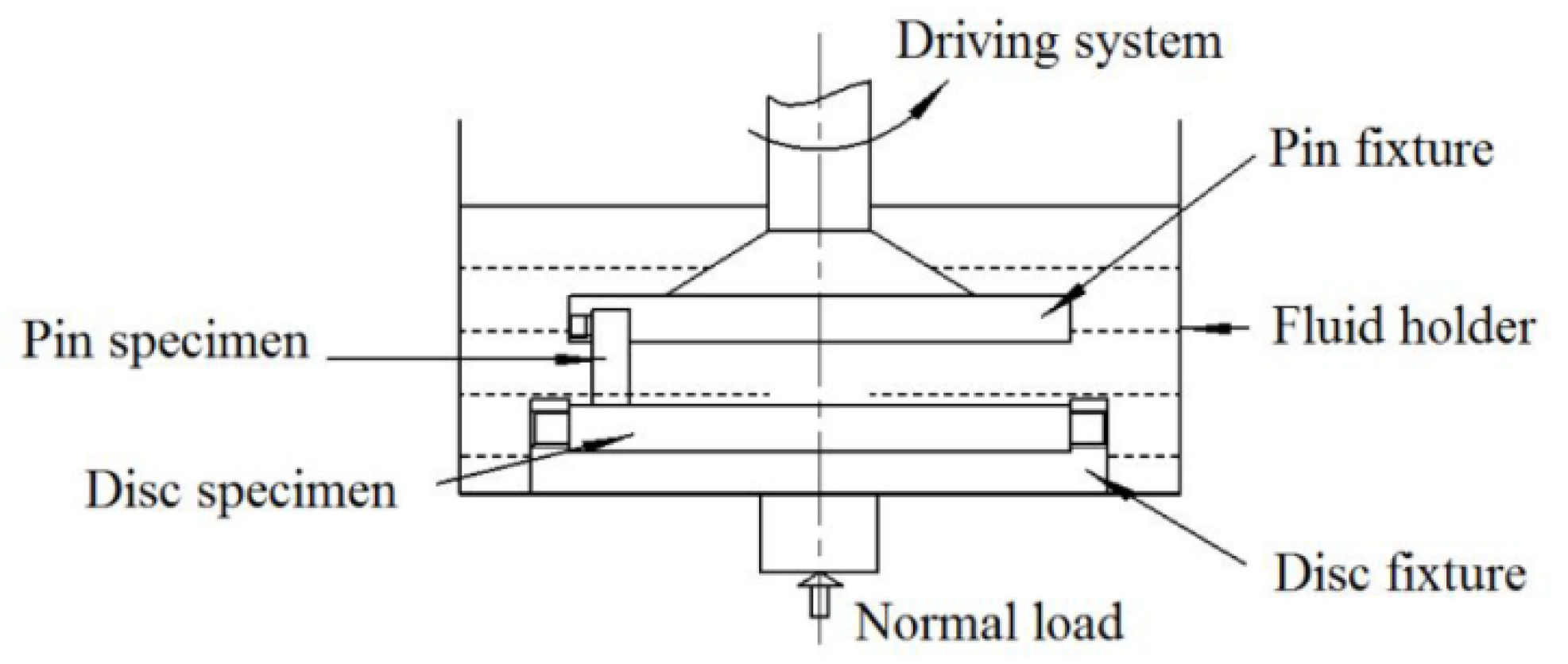
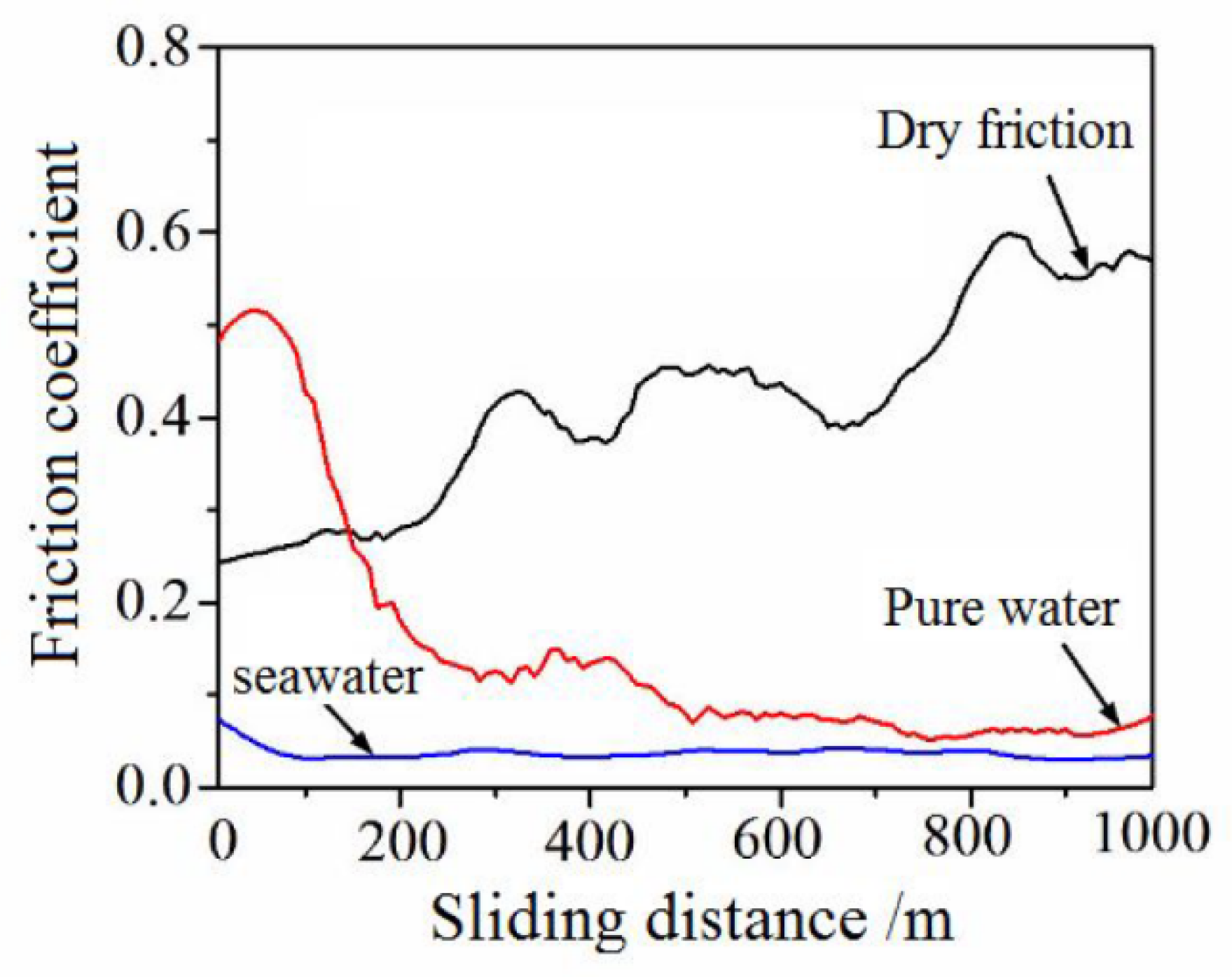
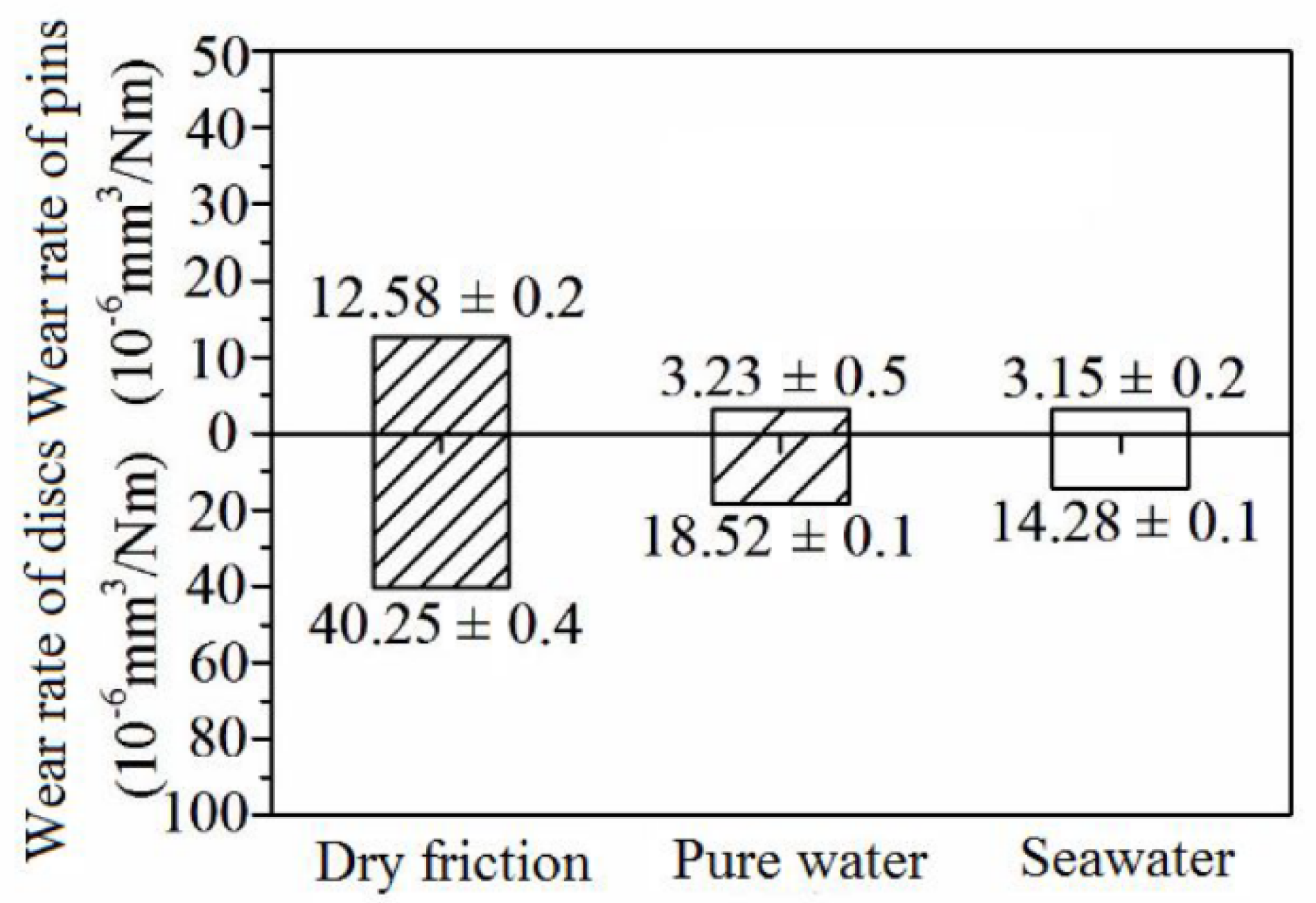
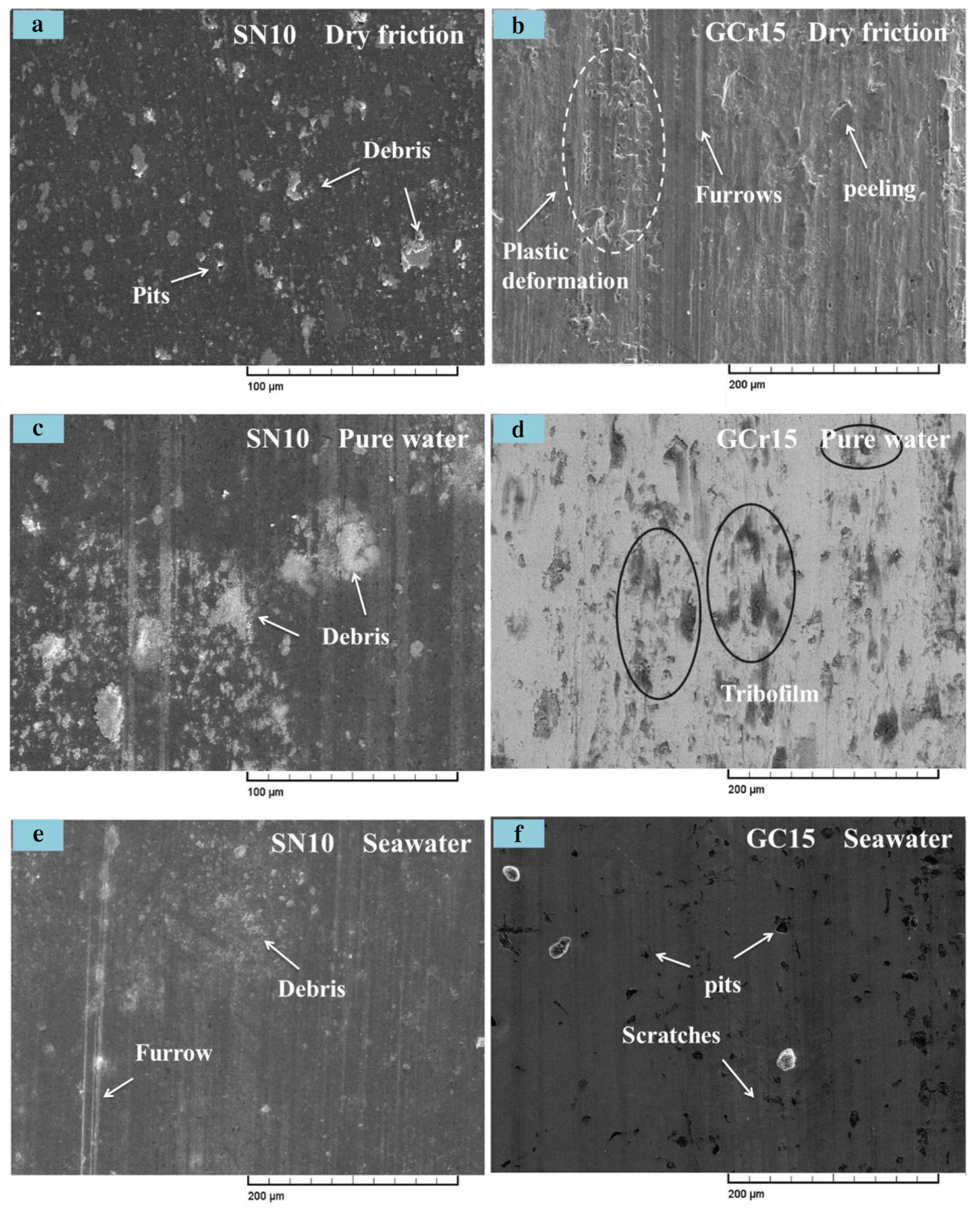
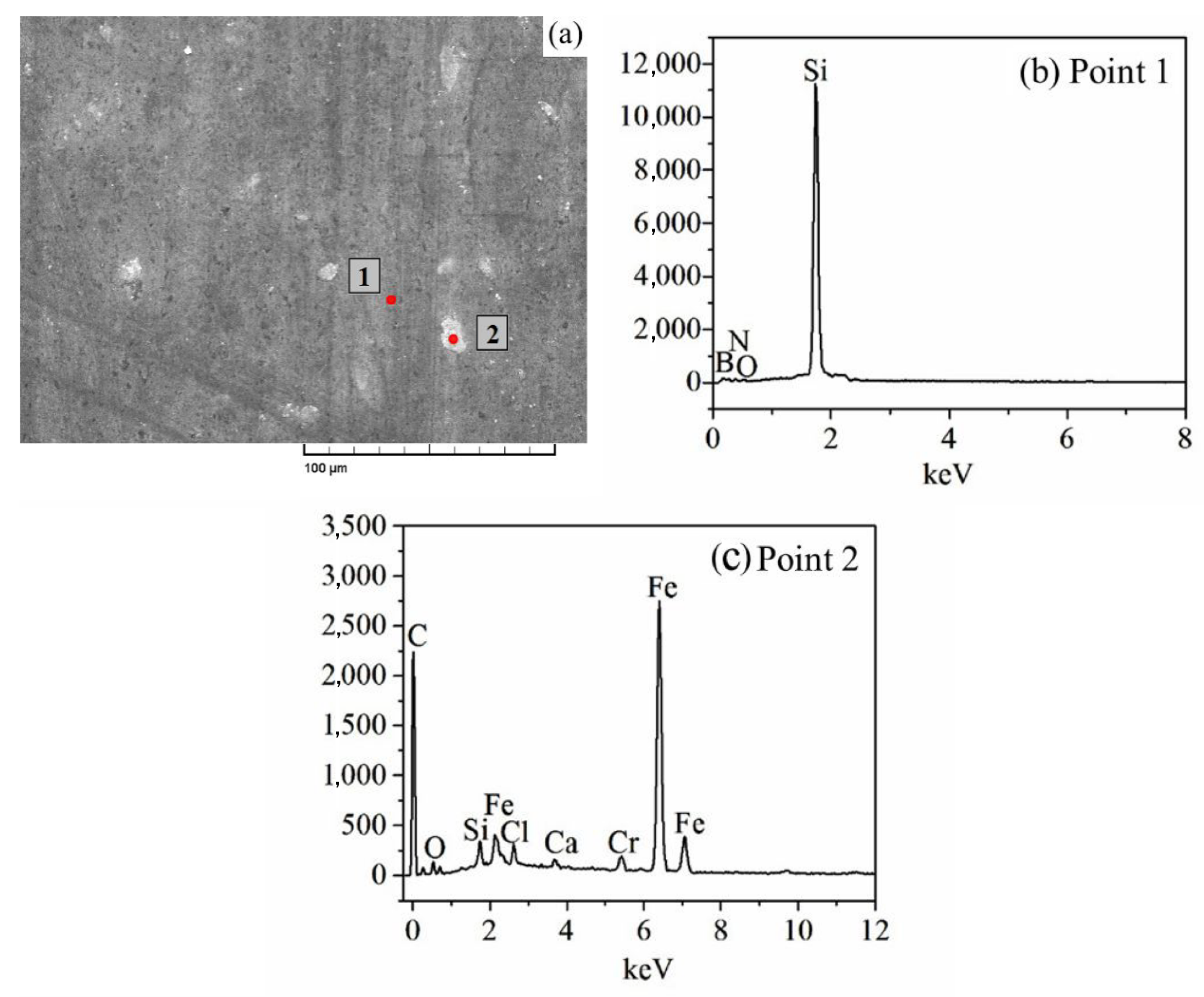
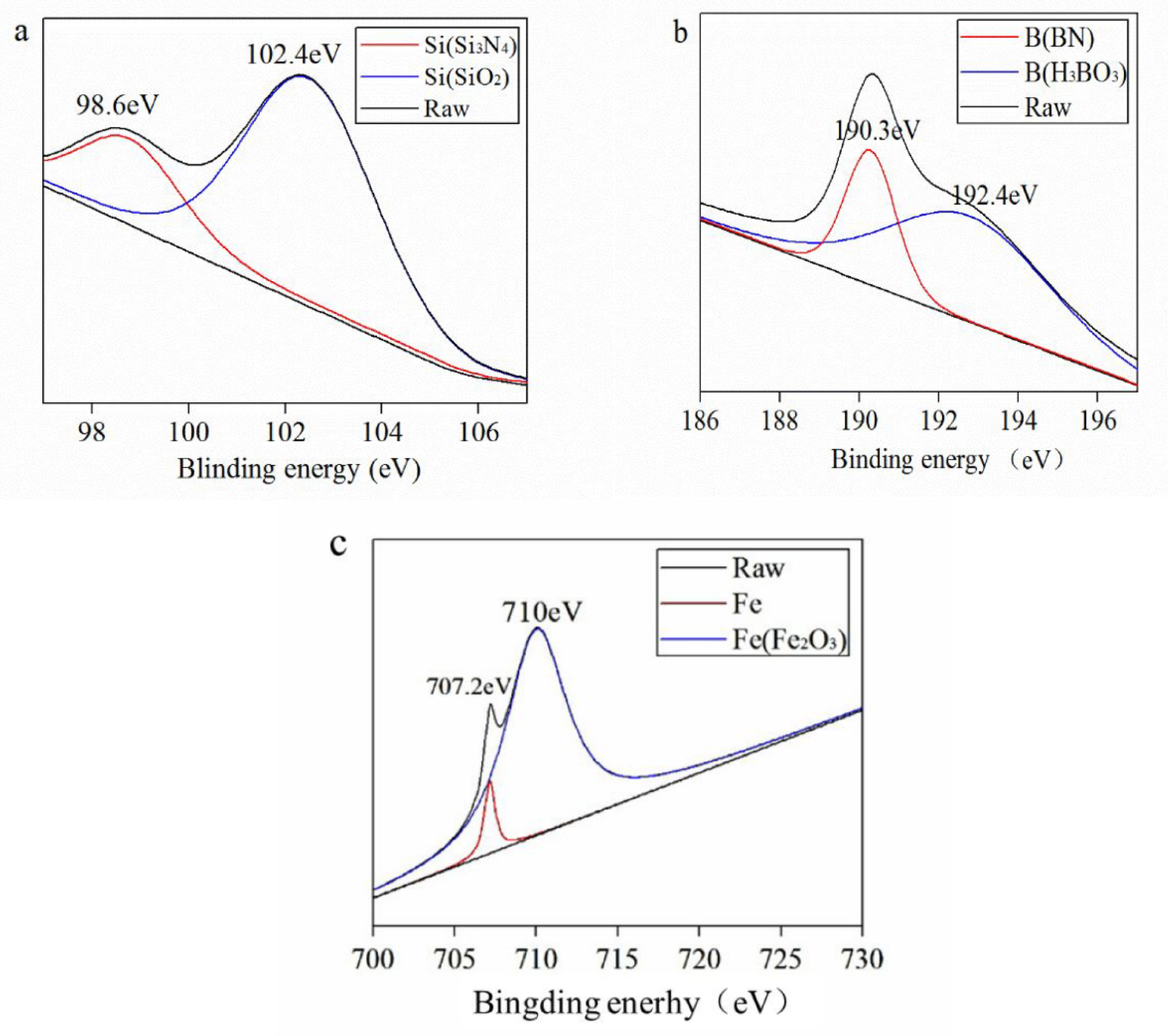
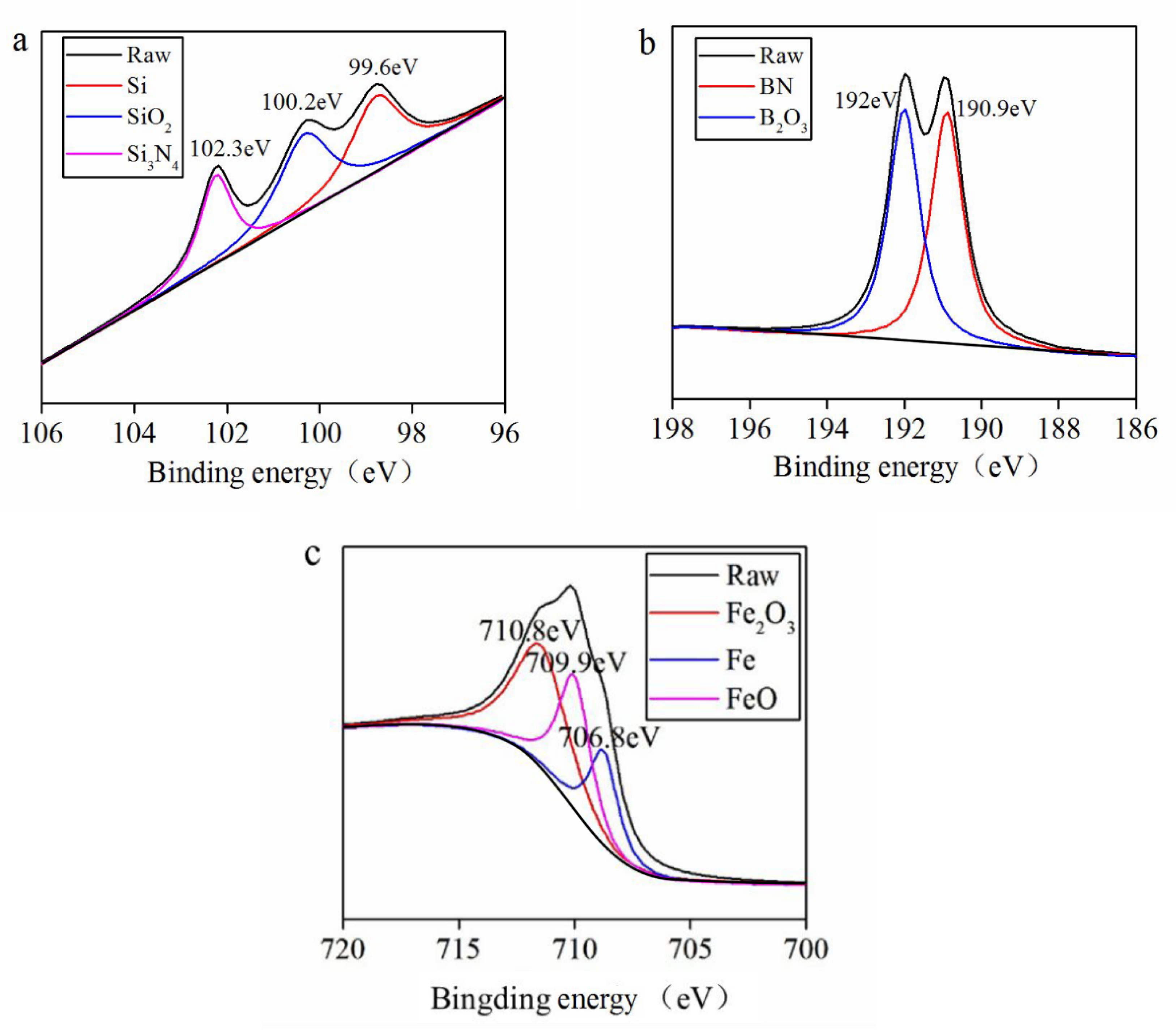

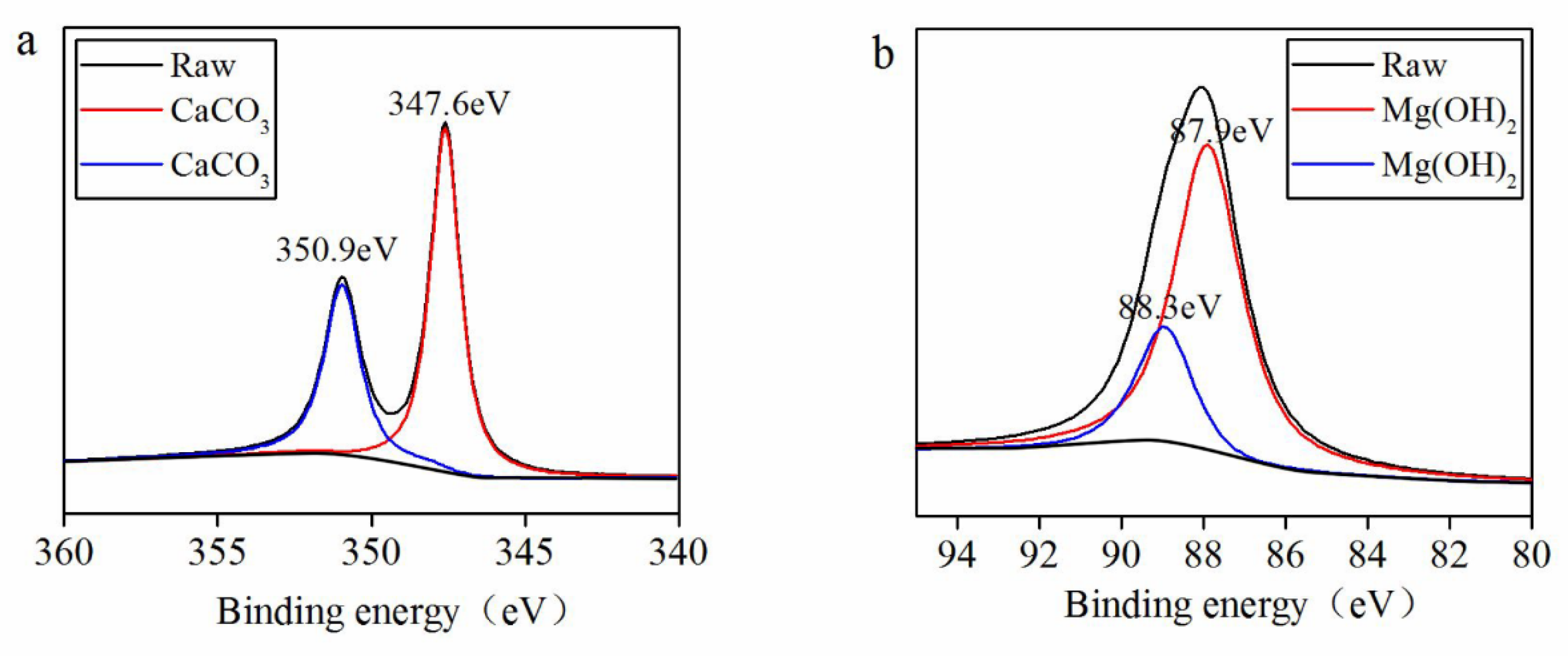
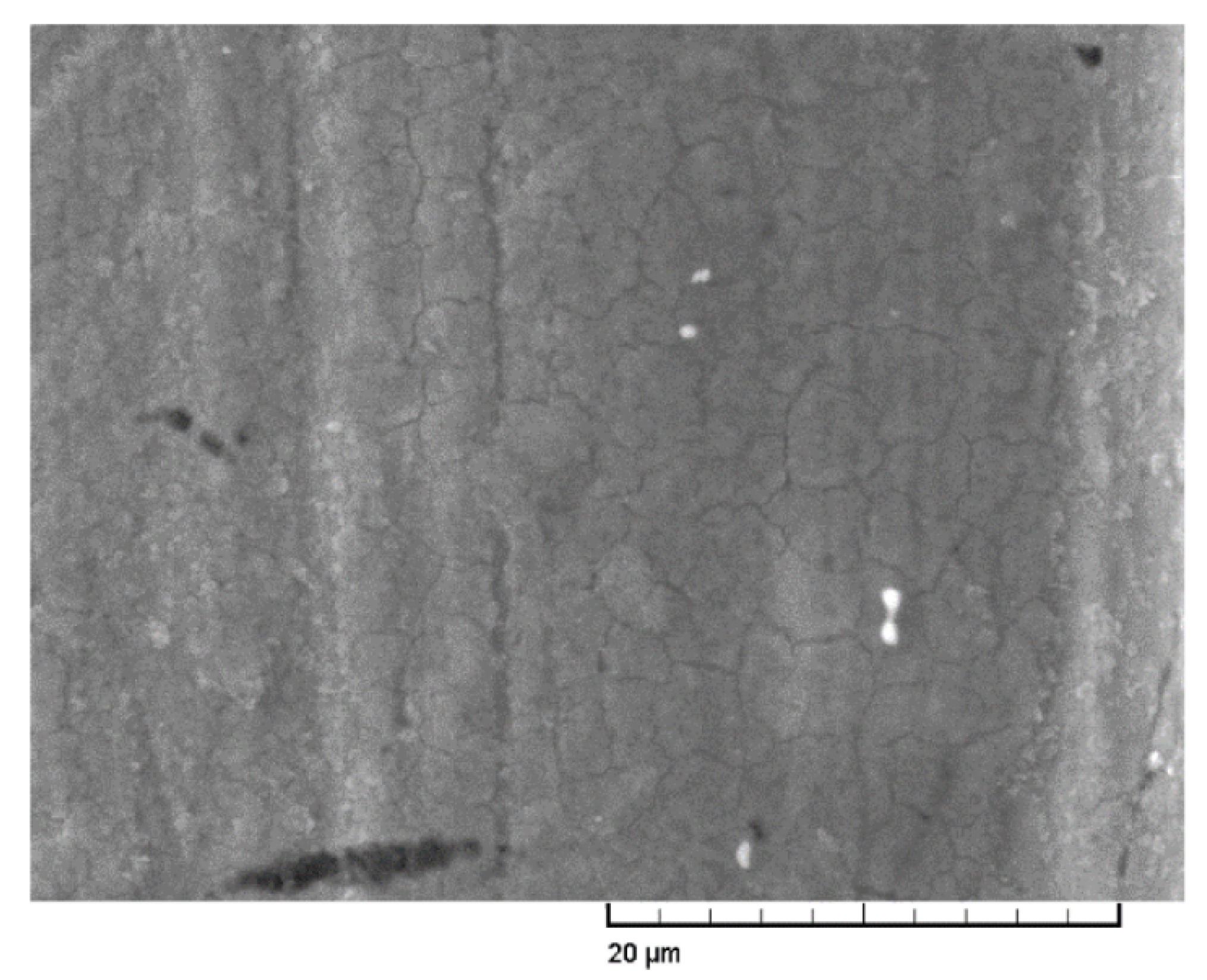

| Specimens | Density (g/cm3) | Porosity (%) | Bending Strength (MPa) | Vickers Hardness (GPa) | Fracture Toughness (MPa·m1/2) |
|---|---|---|---|---|---|
| SN10 | 3.10 | 0.91 | 613 | 15.3 | 7.14 |
| Specimens | Density (g/cm3) | Tensile Strength (MPa) | Bending Strength (MPa) | Rockwell Hardness (GPa) | Impacting Energy (J) |
|---|---|---|---|---|---|
| GCr15 | 7.81 | 1902 | 1617 | 63 | 26 |
| Grade | Components (wt%) | ||||||
|---|---|---|---|---|---|---|---|
| C | S | Si | P | Mn | Ni | Cr | |
| GCr15 | 0.95 | ≤0.020 | 0.27 | ≤0.027 | 0.36 | ≤0.30 | 1.49 |
| Constituent | Concentration (g/L) |
|---|---|
| NaCl | 24.53 |
| MgCl2 | 5.20 |
| Na2SO4 | 4.09 |
| CaCl2 | 1.16 |
| KCl | 0.695 |
| NaHCO3 | 0.201 |
| KBr | 0.101 |
| H3BO3 | 0.027 |
| SrCl2 | 0.025 |
| NaF | 0.003 |
| Tribopair | Conditions | Tribo-Chemical Products | Wear Mechanisms |
|---|---|---|---|
| SN10/GCr15 | seawater | SiO2, B2O3, Fe2O3, FeO, CaCO3, Mg(OH)2 | hydrodynamic lubrication, boundary lubrication |
| SN10/GCr15 | dry friction | SiO2, H3BO3, Fe2O3 | adhesive wear, abrasive wear |
| SN10/GCr15 | pure water | SiO2, B2O3, Fe2O3, FeO | hydrodynamic lubrication |
© 2020 by the authors. Licensee MDPI, Basel, Switzerland. This article is an open access article distributed under the terms and conditions of the Creative Commons Attribution (CC BY) license (http://creativecommons.org/licenses/by/4.0/).
Share and Cite
Han, F.; Wen, H.; Sun, J.; Wang, W.; Fan, Y.; Jia, J.; Chen, W. Tribological Properties of Si3N4-hBN Composite Ceramics Bearing on GCr15 under Seawater Lubrication. Materials 2020, 13, 635. https://doi.org/10.3390/ma13030635
Han F, Wen H, Sun J, Wang W, Fan Y, Jia J, Chen W. Tribological Properties of Si3N4-hBN Composite Ceramics Bearing on GCr15 under Seawater Lubrication. Materials. 2020; 13(3):635. https://doi.org/10.3390/ma13030635
Chicago/Turabian StyleHan, Fang, Huaixing Wen, Jianjian Sun, Wei Wang, Yalong Fan, Junhong Jia, and Wei Chen. 2020. "Tribological Properties of Si3N4-hBN Composite Ceramics Bearing on GCr15 under Seawater Lubrication" Materials 13, no. 3: 635. https://doi.org/10.3390/ma13030635
APA StyleHan, F., Wen, H., Sun, J., Wang, W., Fan, Y., Jia, J., & Chen, W. (2020). Tribological Properties of Si3N4-hBN Composite Ceramics Bearing on GCr15 under Seawater Lubrication. Materials, 13(3), 635. https://doi.org/10.3390/ma13030635





